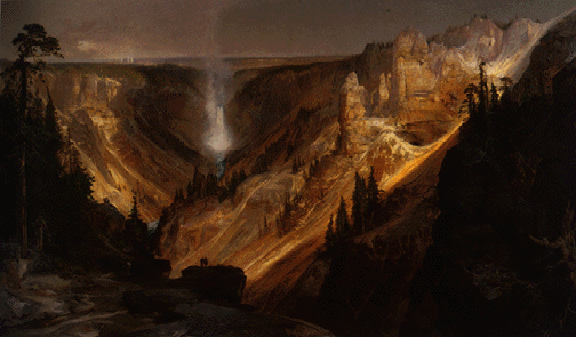

It is a testimonial to the spectacular nature of the wonders of Yellowstone that three "discovery" expeditions were required before the American public would believe that such a place existed. Exploring parties of 1869, 1870, and 1871 each played a role in revealing Yellowstone to the world.
In September of 1869, three prospectors from Diamond City (near present-day Helena), Montana Territory, headed south to investigate the persistent rumors of unbelievable curiosities near the headwaters of the Yellowstone River. These men, known as the Folsom-Cook-Peterson Expedition, spent 36 days exploring and mapping the Yellowstone region. They were astounded by what they saw. Upon reaching the Grand Canyon of the Yellowstone, Charles Cook said, "it seemed to me that it was five minutes before anyone spoke." Returning to Diamond City, they wrote a magazine article about their experiences and made the suggestion that the area be reserved in the public interest.
Excitement about the stories of the Yellowstone area was at a fever pitch when in August 1870 a party of 19 men, 40 horses, and a dog left Helena to further explore the region. This group, the Washburn-Langford-Doane expedition, was composed of prominent Montana territorial citizens, and they spent a month exploring the present park, giving names to many of its features, including Old Faithful Geyser.
 Following the return of the expedition to Helena,
Nathaniel P. Langford (an employee of the Northern
Pacific Railroad, which would play a prominent role in
advertising the future park) traveled to the East Coast
to give speeches promoting their "discovery." Dr.
Ferdinand V. Hayden, then head of what would become
the U.S. Geological Survey, was in one of the
Washington, D.C., audiences. Hayden was intrigued by
Langford's story, and he petitioned Congress for $40,000
to outfit a government scientific party to explore the
Yellowstone country.
Following the return of the expedition to Helena,
Nathaniel P. Langford (an employee of the Northern
Pacific Railroad, which would play a prominent role in
advertising the future park) traveled to the East Coast
to give speeches promoting their "discovery." Dr.
Ferdinand V. Hayden, then head of what would become
the U.S. Geological Survey, was in one of the
Washington, D.C., audiences. Hayden was intrigued by
Langford's story, and he petitioned Congress for $40,000
to outfit a government scientific party to explore the
Yellowstone country.
The expedition traveled west (see picture, by William Henry Jackson, at left) during the summer of 1871 and spent many months in Yellowstone, confirming the Washburn party's discoveries, taking scientific readings, and accurately mapping the area. Hayden's party of about 30 men included an artist, Thomas Moran, and a photographer, William H. Jackson. Their artwork and photographs played an important role in convincing a skeptical nation of the wonders of Yellowstone.
In the winter of 1871, a bill was introduced into Congress
to set the Yellowstone area aside. On March 1, 1872,
President Ulysses S. Grant signed the bill that reserved
Yellowstone as a public park, "forever free from
settlement, occupancy or sale . . . for the benefit and
enjoyment of the people."
![]() Comments
and Questions are Welcome.
Comments
and Questions are Welcome.
This site is hosted by Geocities. Get your own Free Homepage.